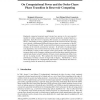108 search results - page 20 / 22 » Randomized Optimum Models for Structured Prediction |
ISI
2006
Springer
13 years 7 months ago
2006
Springer
In the paper we combine a Bayesian Network model for encoding forensic evidence during a given time interval with a Hidden Markov Model (EBN-HMM) for tracking and predicting the de...
ACL
2006
13 years 9 months ago
2006
This paper shows that a simple two-stage approach to handle non-local dependencies in Named Entity Recognition (NER) can outperform existing approaches that handle non-local depen...
BMCBI
2007
13 years 7 months ago
2007
Background: Most methods for predicting functional sites in protein 3D structures, rely on information on related proteins and cannot be applied to proteins with no known relative...
CIKM
2004
Springer
14 years 28 days ago
2004
Springer
We examine the problem of retrieving the top-m ranked items from a large collection, randomly distributed across an n-node system. In order to retrieve the top m overall, we must ...
NIPS
2008
13 years 9 months ago
2008
Randomly connected recurrent neural circuits have proven to be very powerful models for online computations when a trained memoryless readout function is appended. Such Reservoir ...

